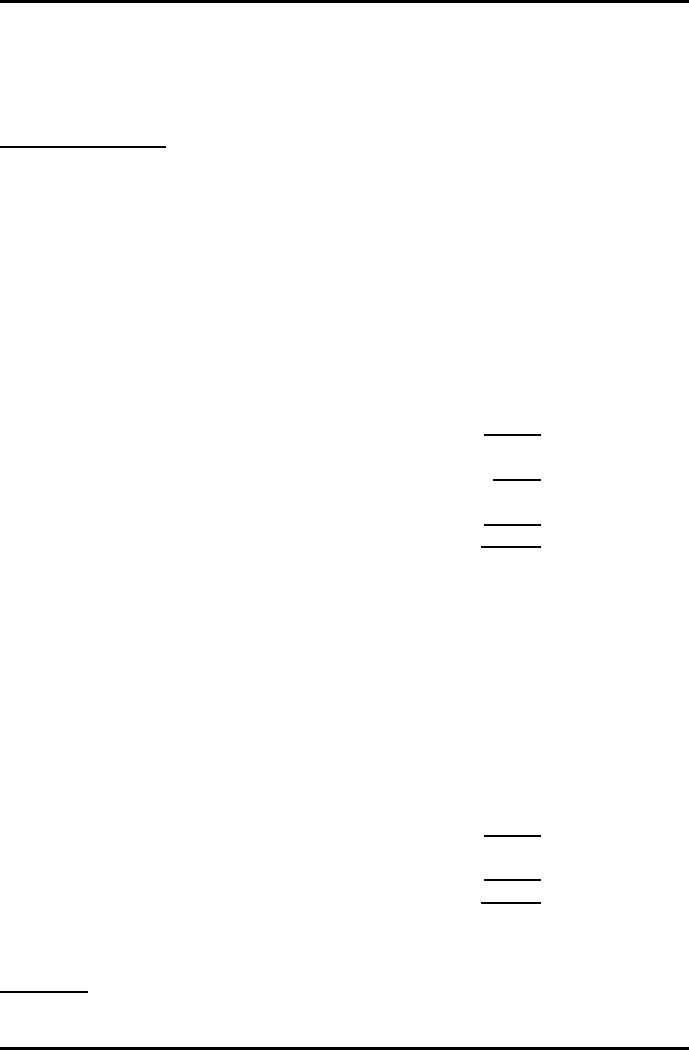 |
DILUTED EARNINGS PER SHARE |
| << Earnings per Share |
| GROUP ACCOUNTS >> |

Advance
Financial Accounting
(FIN-611)
VU
LESSON
# 35
DILUTED
EARNINGS PER SHARE
At
the end of an accounting
period, a company may have in
issue some securities
which do not
(at present) have any claim
to a share of equity earnings, but may
give
rise
to such a claim in the
future. These securities
include:
a)
A
separate class of equity
shares which at present is not entitled
to any
dividend,
but will be entitled after some future
date
b)
Convertible
Debentures or convertible preferred
shares which give
their
holders
the right at some future date to
exchange their securities
for
ordinary
shares of the company, at a
pre-determined conversion
rate
c)
Option
or warrants
In
such circumstances, the future number of
ordinary shares in issue might
increase.
This
in turn results in a fall in the EPS. In
other words, a future increase in
the number
of
ordinary shares will cause a dilution of
equity, and it is possible to calculate
diluted
earnings
per share (i.e. the
EPS that would have been
obtained during the
financial
period
if the dilution had already taken
place). This will indicate to
investors the
possible
effects of a future dilution.
Earnings:
The
earnings calculated for basic
EPS should be adjusted by
the post-tax
(including
deferred
tax) effect of
a)
Any
dividends on dilutive potential
ordinary shares that were
deducted to
arrive
at earnings for basic
EPS
b)
Interest
recognized in the period for
the dilutive potential
ordinary shares
c)
Any
other changes in income or
expenses (fee and discount,
premium
accounted
for as yield adjustments) that would
result from the conversion
of
the
dilutive potential ordinary
shares
The
conversion of some potential
ordinary shares may lead to
changes in other
income
or
expenses. For example, the
reduction of interest expense
related to potential
ordinary
shares and the resulting
increase in net profit for
the period may lead to
an
increase
in the expense relating to
non-discretionary employee profit
sharing plan.
When
calculating diluted EPS, the
net profit or loss for the
period is adjusted for any
such
consequential changes in income or
expense.
Per
Share:
The
number of ordinary shares is the
weighted average number of ordinary
shares
calculated
for basic EPS plus the
weighted average number of shares
that would be
188

Advance
Financial Accounting
(FIN-611)
VU
issued
on the conversion of all the
dilutive potential ordinary
shares into ordinary
shares.
It
should be assumed that
diluted ordinary shares were
converted into ordinary
shares
at
the beginning of the period
or, if later, at the actual
date of issue.
Solved
problem # 1:
Basic
EPS of a company is Rs. 1.05
per share based on earnings
of Rs. 105,000 and
100,000
ordinary Re. 1 shares. It
also had in issue Rs. 40,000
15% Convertible
Debentures
which is convertible in two years' time
at the rate of 4 ordinary
shares for
every
Rs. 5 of debenture. The rate
of tax is 30%. In 2007 gross
profit of Rs. 200,000 and
expenses
of Rs. 50,000 were recorded,
including interest payable of
Rs. 6,000
Income
Statement before conversion of
debentures into the ordinary
shares
Rupees
Gross
profit
200,000
Operating
expenses
(44,000)
Profit
from operations
156,000
Financial
expenses
(6,000)
Profit
before tax
150,000
Income
tax 30%
(45,000)
Profit
after tax (earnings)
105,000
Diluted
earnings per
share
a)
Conversion
of debentures into the ordinary number of
shares
Rs.
40,000 x 4/5 = 32,000 number of ordinary
shares
b)
Adjustment
of profits after the
conversion of debentures into the
ordinary
shares
c)
Rupees
Gross
profit
200,000
Operating
expenses
(44,000)
Profit
from operations
156,000
Income
tax 30%
(46,800)
Profit
after tax (earnings)
109,200
d)
Diluted
EPS
Rs.
109,200 = Rs. 0.827 per
share
132,000
189

Advance
Financial Accounting
(FIN-611)
VU
e)
Dilution:
The
dilution in earnings would be Rs. 1.05
less 0.827 = Rs.
0.223/share.
Dilutive
potential ordinary shares
Those
convertible debentures or securities
that will cause an increase in
Basic EPS had
these
would have been converted in
the current year are
anti-dilutive potential
ordinary
shares.
According
to IAS 33, potential ordinary
shares should be treated as
dilutive when, and
only when,
their conversion to ordinary
shares would decrease net
profit per share
from
continuing operations. This
point is illustrated in the following
example:
Profit
from operations
156,000
Financial
charges (interest @ 25%of
Rs. 40,000 debentures)
(10,000)
Profit
before tax
146,000
Income
tax (@ 30%)
(43,800)
Profit
after tax
102,200
Ordinary number
of shares
100,000
Basic
EPS
Rs.
123,300 = Rs. 1.022 per
shares
100,000
shares
Diluted
EPS
Conversion
rate is 3 ordinary shares will be
issued against each Rs. 20
debentures in
issue
Rs.
40,000 x 3/20 = 6,000 number of
shares
Revised
Income statement after
conversion
Rupees
Profit
from operations
156,000
Financial
charges
0
Profit
before tax
156,000
Income
Tax @ 30%
(46,800)
Profit
after tax
109,200
Revised
earnings per share after
conversion
Rs.
109,200 = Rs. 1.030 per
share
106,000shares
There
is no dilution as the post conversion
EPS is greater than the
basic EPS.
This
can also be understood by
calculating individual EPS of
the security/debenture.
If
the individual EPS of the
security is lesser than the
basic EPS then it is a
dilutive
potential
shares, whereas, if the
individual EPS of the
security is greater than the
basic
EPS
then it is a non dilutive potential
shares.
190

Advance
Financial Accounting
(FIN-611)
VU
Like
is this case:
Rupees
Savings
of financial charges
10,000
Income
tax impact @ 30%
(3,000)
Impact
on the earnings to the
extent of the
security
7,000
Rs.
7,000 = Rs. 1.667
Individual
EPS
6,000
shares
This
individual EPS is greater than
the basic EPS i.e.
1.022 per share therefore
this
security
is anti-dilutive potential share and
should not be converted into the
ordinary
shares
before calculating the
diluted earnings per
share.
Solved
problem # 2:
Ali Imran Co
has 5,000,000 ordinary
shares in issue, and also had in
issue in 2004:
a)
Rs.
1,000,000 of 14% convertible
debentures, convertible in three
years'
time
at the rate of 2 shares peer
Rs. 10 of debentures
b)
Rs.
2,000,000 of 10% convertible
debentures, convertible in one
year's
time
at the rate of 3 shares per
Rs. 5 of debenture.
�
The
total earnings in 2004 were
Rs. 1,750,000
�
The
rate of income tax is
35%
Requited:
Calculate the basic EPS and
the diluted EPS
Solution:
Basic EPS
=
Rs. 1,750,000 = 35
paisa
5,000,000
Diluted
EPS:
Before
calculating diluted EPS we must
decide which of the potential
ordinary shares
(the
convertible debentures) are
dilutive.
a)
Conversion
into ordinary shares Rs.
1,000,000 x 2/10 = 20,000 ordinary
shares
Savings
of financial charges Rs.
1,000,000 x 14%
140,000
Income
tax impact @ 35%
(49,000)
Impact
on the earnings to the
extent of the
security
91,000
Individual
EPS
Rs.
91,000 = 45.5 paisa (greater
than the basic EPS)
20,000
191

Advance
Financial Accounting
(FIN-611)
VU
b)
Conversion
into ordinary shares Rs.
2,000,000 x 3/5 = 1,200,000 ordinary
shares
Savings
of financial charges Rs.
2,000,000 x 10%
200,000
Income
tax impact @ 35%
(70,000)
Impact
on the earnings to the
extent of the
security
130,000
Individual
EPS
Rs.
130,000 = 10.8 paisa (lesser than
the basic EPS)
1,200,000
Therefore
the diluted EPS will be
calculated after converting
the 10% debentures.
Rs.
1,750,000 + Rs. 130,000 = Rs.
1,880,000 = 30.30
paisa
5,000,000
+ 1,200,000
6,200,000
Dilution
is equal to
Basic
EPS
35.00
Diluted
EPS
30.30
Dilution
4.70
192
Table of Contents:
- ACCOUNTING FOR INCOMPLETE RECORDS
- PRACTICING ACCOUNTING FOR INCOMPLETE RECORDS
- CONVERSION OF SINGLE ENTRY IN DOUBLE ENTRY ACCOUNTING SYSTEM
- SINGLE ENTRY CALCULATION OF MISSING INFORMATION
- SINGLE ENTRY CALCULATION OF MARKUP AND MARGIN
- ACCOUNTING SYSTEM IN NON-PROFIT ORGANIZATIONS
- NON-PROFIT ORGANIZATIONS
- PREPARATION OF FINANCIAL STATEMENTS OF NON-PROFIT ORGANIZATIONS FROM INCOMPLETE RECORDS
- DEPARTMENTAL ACCOUNTS 1
- DEPARTMENTAL ACCOUNTS 2
- BRANCH ACCOUNTING SYSTEMS
- BRANCH ACCOUNTING
- BRANCH ACCOUNTING - STOCK AND DEBTOR SYSTEM
- STOCK AND DEBTORS SYSTEM
- INDEPENDENT BRANCH
- BRANCH ACCOUNTING 1
- BRANCH ACCOUNTING 2
- ESSENTIALS OF PARTNERSHIP
- Partnership Accounts Changes in partnership firm
- COMPANY ACCOUNTS 1
- COMPANY ACCOUNTS 2
- Problems Solving
- COMPANY ACCOUNTS
- RETURNS ON FINANCIAL SOURCES
- IASB’S FRAMEWORK
- ELEMENTS OF FINANCIAL STATEMENTS
- EVENTS AFTER THE BALANCE SHEET DATE
- PROVISIONS, CONTINGENT LIABILITIES AND CONTINGENT ASSETS
- ACCOUNTING POLICIES, CHANGES IN ACCOUNTING ESTIMATES AND ERRORS 1
- ACCOUNTING POLICIES, CHANGES IN ACCOUNTING ESTIMATES AND ERRORS 2
- BORROWING COST
- EXCESS OF THE CARRYING AMOUNT OF THE QUALIFYING ASSET OVER RECOVERABLE AMOUNT
- EARNINGS PER SHARE
- Earnings per Share
- DILUTED EARNINGS PER SHARE
- GROUP ACCOUNTS
- Pre-acquisition Reserves
- GROUP ACCOUNTS: Minority Interest
- GROUP ACCOUNTS: Inter Company Trading (P to S)
- GROUP ACCOUNTS: Fair Value Adjustments
- GROUP ACCOUNTS: Pre-acquistion Profits, Dividends
- GROUP ACCOUNTS: Profit & Loss
- GROUP ACCOUNTS: Minority Interest, Inter Co.
- GROUP ACCOUNTS: Inter Co. Trading (when there is unrealized profit)
- Comprehensive Workings in Group Accounts Consolidated Balance Sheet